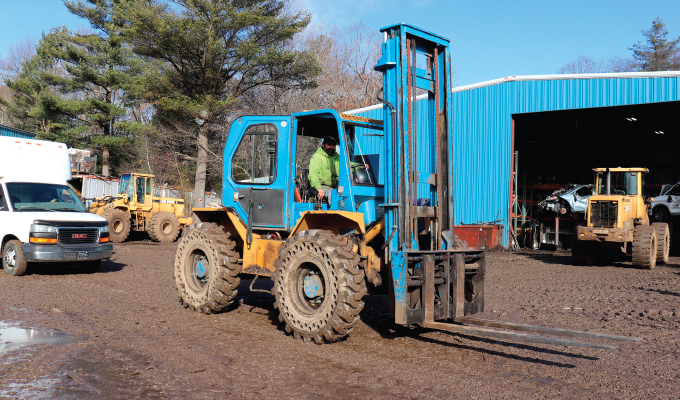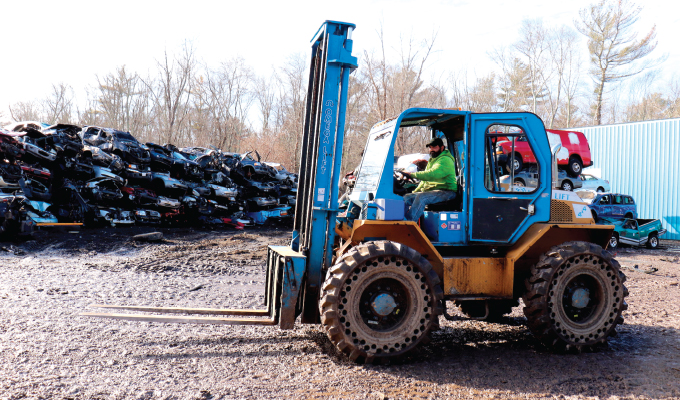By Timothy Peck
There are almost 900,000 forklifts in operation across the United States, working in industries such as warehouses, docks, construction, manufacturing, and any other sector that requires moving bulky loads over short distances. The types of forklifts are almost as diverse as the industries they work in—models vary in everything from their mode of power (gas/electric) to lift capacity and lift height. But one important element ties all forklifts together and deserves focus, says Alliance Tire Americas’ Ryan Lopes, national product manager—materials handling and solid tires: their tires.
“The dramatic effect tires have on a forklift’s performance and an operation’s bottom line is a unifying factor among forklifts—regardless of the industry they work in or specifications they’re built to,” says Lopes.
INFLUENCE ON PERFORMANCE
Tires can account for up to 30 percent of fleet maintenance costs, making them one of the highest maintenance expenses relating to forklifts. Because of this, ATA’s Lopes says that “more and more operators are choosing application-specific forklift tires to reduce replacement costs, along with improving the efficiency and productivity of their machines.”
Lopes suggest these general rules for matching a forklift tire to an application:
- Pneumatic tires: air- or foam-filled tires that are best for long-distance operations where there is no imminent threat of punctures
- Press-on band tire: shallow, single-compound, solid tires fused to a steel band, are perfect for indoor warehouse operations where stability is critical
- Resilient solid tires: solids that can consist of several layers of compound and are mounted like conventional tires are ideal for applications that require the puncture-proof performance of a press-on and the cushioning effect of a pneumatic
Below are some other criteria Lopes encourages forklift owners to consider when choosing tires:
1. WHERE THE FORKLIFT WILL WORK
Tires with a tread pattern will provide superior performance when working on wet or rough surfaces, or if the equipment moves outdoors, up and down ramps, or on other undulating terrains. Smooth tires are ideal for improved, dry surfaces like concrete or asphalt.
“Equally important is to consider fitment when purchasing a forklift,” says Lopes. “For example, if your forklift is working outside of a warehouse, you’ll want a machine with hubs that accommodate rims—allowing for the use of resilient solid or pneumatic tires—rather than a machine equipped with press-on band tires.”
2. HOW THE FORKLIFT TIRE WILL WORK
Pneumatic tires provide the best cushioning for equipment and more easily dissipate heat (the No. 1 enemy of tires), making them the best choice for machines traveling long distances, working nonstop, and doing a lot of starting and stopping. Of course, for a pneumatic tire to perform its best, it needs to be inflated to the proper air pressure—another factor to keep in mind when choosing a tire.
Solid and press-on tires are the way to go for defeating downtime due to punctures. These tires last longer than pneumatics, have higher load-carrying capacities, and are more resistant to scrubbing from harsh surfaces. Because of this, Lopes recommends solid press-on tires for “indoor jobs on surfaces such as concrete and on forklifts required to handle heavy loads and lift these loads to new heights.” Press-on band tire construction is the most stable tire configuration and makes applications involving lifting to heights easier.
Resilient solids or pneumatic-shaped solids are an excellent solution for machines operating under less extreme circumstances. “They offer the solid construction of a press-on tire with a cushion layer to improve ride quality and provide incremental tread depths for reducing switch over costs,” says Lopes.
3. THE IMPORTANCE OF PUNCTURE PROTECTION
No operation wants downtime caused by punctures, but some applications present a greater puncture threat than others. Solid and press-on tires are puncture-proof, making them the go-to choice for applications where the threat of a flat is imminent. Lopes reminds customers that “punctures are the result of more than just sharp debris; floors with rough seams, raised expansion joints, and metal dock plates are also common causes of flats in forklifts.”
4. THE INTENSITY OF YOUR OPERATION
Often overlooked when it comes time to choose a tire is how hard you’ll ask it to work. “The tire requirements of a machine that works sporadically throughout the day to one that runs nonstop for multiple shifts are vastly different,” Lopes says.
For forklifts that are continuously operating over the course of multiple shifts, heat management is critical, making a pneumatic tire a sensible choice. But if the forklift is working in an environment where there’s a high likelihood of punctures, a resilient solid tire will provide the optimal blend of heat dissipation and puncture resistance. Solid tires have various constructions and compound formulations, however, so identifying the right tire to match the level of intensity of your application is critical to achieving a better total cost of ownership—this is where involving the expertise of a tire dealer (or the tire manufacturer) is critical.
5. THE IMPORTANCE OF OPERATOR COMFORT
The happiness of your operators can affect everything from the productivity of your operation to your ability to retain valuable employees. Tires act as the suspension for all forklifts, and pneumatic tires provide a more comfortable ride than solid or press-on tires. Pneumatics not only provide a softer ride for the operator, but they’re also easier on machines—cutting down on wear and tear.
6. WHO IS OPERATING THE FORKLIFT
The person operating the forklift can have an oversized impact on the life of your tires. Inexperienced operators are likely to be harder on tires than seasoned pros, and the robust construction of solid and press-on tires offers a simple solution to aggressive or inexperienced operators.
Lopes points out: “It’s not just new operators bumping into curbs or scraping against racking that makes them so tough on tires. It’s also their tendency for aggressive starting and stopping.” Short stops can cause flat spots on a tire while overloading a machine, and driving forklifts too fast can create heat build-up in a tire and shorten its lifespan.
APPLICATION-SPECIFIC TIRES
“Forklifts come in all shapes and sizes and work in all types of industries, and there’s no one-size-fits-all tire solution,” says Lopes. “Because of this, ATG offers a variety of application-specific tires for forklifts. For instance, we manufacture our Galaxy Yardmaster brand—a special tire developed for forklifts operating on hard surfaces—as a pneumatic radial and bias as well as a solid, meaning there’s a Yardmaster available for a variety of applications to meet your every need. We also offer a wide range of tread patterns in forklift sizes so machinery owners can choose the optimum tire for their situation.”

CLOSING THOUGHT
The simple fact is that matching the tires on your machine to the application it’s asked to perform can have a positive effect that ripples through your operation.
For more information:
Alliance Tire Americas, Inc. is the American sales and marketing arm of Alliance Tire Group (ATG), a global leader in tires for construction, material handling, agriculture, logging, and other off-the-road (OTR) uses. For more, call 800.343.3276, or visit www.atgtire.com.
Modern Contractor Solutions, April 2020
Did you enjoy this article?
Subscribe to the FREE Digital Edition of Modern Contractor Solutions magazine.



